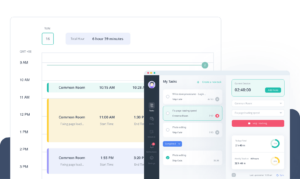
What Is The 2-2-3 Work Schedule will be explained in this article. There are many different types of workplaces worldwide. Some workplaces can’t function without round-the-clock security. Security, healthcare, retail, law enforcement, military, fire service, transportation, restaurants, airlines, manufacturing, gas stations, customer service call centers, media, and newspapers are among the industries where such a situation is seen. It is not possible for one employee to provide round-the-clock coverage.
What Is The 2-2-3 Work Schedule Complete Guide
In this article, you can know about What Is The 2-2-3 Work Schedule here are the details below;
Shift work has become popular as a result. The Panama 2-2-3 work pattern is among the finest for shift work. Every firm needs to arrange shifts for its personnel since it will help them balance their personal and professional lives.
What is the 2-2-3 work schedule?
With four teams of workers, a 2-2-3 work plan offers 24-hour coverage through rotating shift work. Every crew works two consecutive day shifts, then gets a two-day break before working three more days.
Typically, it is a 28-day rotational cycle where each person works 12 hour shifts. Two days off precede two workdays and three rest days in the second week. Then, at the start of the third week of the month, the entire procedure will be repeated.
Detailed overview of the Panama 2-2-3 work schedule
With the 2-2-3 work schedule, also known as the Panama schedule, you have three weekends per alternating week and are spared from working more than two days under pressure.
Below, let’s talk about shift labor and its various forms:
What is Shift Work?
The “labor working hours” movement is thought to have started around 1835. In Philadelphia, laborers united under the leadership of Irish coal miners. In 1836, labor movement newspapers demanded eight hours of work a day. However, as industrialization, globalization, and the technological boom occur, the need for working hours is progressively shifting with the passage of time.
These days, most businesses require labor and a working atmosphere that is open 24/7. Thus, shift work has been used to lessen the demands on the companies.
A young woman is using a keyboard as the day and night cycles continue.
What is Shift Scheduling
One essential component of shift work is shift scheduling. It is carried out to ensure that shift work runs smoothly. Companies that use efficient scheduling can reduce labor costs, boost productivity, and foster a positive work environment for their staff.
Breaking up shifts into multiple periods might be more dynamic and difficult. While some businesses choose to implement rotating shift plans, others choose to implement permanent schedules.
Fixed Shift
A fixed shift is one in which an employee works the same shift each day. First, second, or third shifts are examples of fixed shifts where workers are not required to work nonstop but must complete their tasks at the same time each day.
Let’s take an example where a business requires staff engagement around-the-clock. Additionally, the company’s staff dislikes having their work schedules changed. Then, fixed scheduling could be a wise decision for the business.
Advantages of Fixed Shift
- Coordination and communication are efficiently managed.
- Workers can stick to a set schedule.
- Operational expenses are much lower.
- Employees can make advance plans thanks to fixed weekends.
Drawbacks of Fixed Shift
- Unflexible scheduling leads to employee unhappiness
- Rush hour is present during most set times, which discourages travel.
- The majority of working hours are spent ineffectively.
Rotating Shift
Working any of the shifts—first, second, or third—whenever the employee is instructed to is known as shift rotation. An employee might work the night shift the next day after working the morning shift the day before. Manager to manager variations exist in rotation patterns. The person who decides on an employee’s rotation schedule is the management.
Is Rotating Shift Necessary Evil?
Workers with rotating shift schedules have higher levels of exhaustion, stress, insomnia, and occasionally trouble eating. Workers on the day shift sleep soundly at night, whereas those working the night shift won’t sleep well the next day.
Businesses cannot sacrifice productivity. Alternatively, they could try switching shifts to experience an even or odd shift that tastes comparable. Take a look at the 9/80 work schedule, which allows you to receive an additional day off every two weeks.
What is the Panama 2-2-3 Work Schedule?
This is frequently referred to as “Panama Scheduling.” In order to provide 24/7 service, this type of slow-shift business scheduling runs on four shifts and two 12-hour shifts.
The day shift lasts for the first 12 hours, while the night shift lasts for the next 12. The working and non-working days are tracked using the schedule that follows.
Advantages of 2-2-3 work schedule
- Workers are entitled to three days off on the weekends every alternate week.
- beneficial for military, medical, training, and other administrative tasks.
- There will only be 180 workdays for employees annually.
- Two days of labor as a result.
Drawbacks of 2-2-3 work schedule
- Workers will endure 12-hour workdays without a break and experience boredom.
- Two days of nonstop work, or a total of twenty-four hours, can be harmful to an employee’s health.
- There may be an impact on the sleep cycle.
Variations of 2-2-3 work schedule
Goals and objectives of the organization are primarily dependent on employee productivity. Employee productivity is significantly impacted by shift scheduling. The right employee schedule is determined by organizational culture and the characteristics of the employees.
Let’s talk about the advantages and disadvantages of some of the 2-2-3 Schedule modifications.
Dupont Shift Schedule
DuPont Shift schedule: Four teams work 12-hour shifts. Four nights a week, three days off, three days off, one day off, three nights a week, three days off, four days off, and seven days off make up the DuPont schedule. An employee puts in 42 hours a week on average.
The majority of specialists claim that the Dupont Shift Plan may be used in policy agencies or is effective for industrial enterprises. It is not as advised for small businesses.
Pitman Shift Scheduling
One pattern that is often utilized and provides coverage around-the-clock is the Pitman Shift Pattern. Pitman’s shift plan offers round-the-clock coverage by using two 12-hour shifts and four teams.
It can be used for two-night shifts with a two-day break, three-night shifts with a two-day break, and two-night shifts with a three-day break. Under this shift work pattern, employees have one weekend off every two.
The 24-48 Scheduling
This is a fairly straightforward scheduling procedure to cover a workaholic workplace. Three teams are used to create this pattern. There are three 24-hour shifts in a row. Every team follows the 24-48 schedule, working for 24 hours and then taking a 48-hour break. This means that each worker puts in 56 hours a week on average.
The ABC shift pattern is another name for this. Any employee will benefit much by this 24-48 schedule if their home and place of employment are relatively far apart.
Continental Scheduling
Four teams work in a fast-paced, rotating shift pattern called continental shifts. To cover twenty-four hours a day, it has three 8-hour shifts. Throughout this timetable, each team alternates between two, two, and three consecutive day shifts; swing shifts; night shifts; and two or three days off. An average team schedule for a four-week (28-day) repeat cycle.
For security, social services, healthcare, transportation, and geriatric care, continental shift is perfect. Workers will take at least two days off in a row to unwind and refuel in addition to working brief shifts. Another name for this is 4-on-4-off scheduling.
10 Ways to Manage A 2-2-3 Work Schedule
Make sure that your 2-2-3 working shifts run smoothly and don’t place an excessive burden on the schedules of your staff members. Yes, and it goes without saying that juggling a 2-2-3 work schedule will present difficulties and obstacles. Let’s explore the most effective methods for handling Panama Scheduling.
Providing advance notice of shift rosters
Emergencies occur in the course of business. There is no other way to ensure correct scheduling than to use backup plans. However, staff adoption is required for this.
All schedules ought to be distributed ahead of time so that staff members can adjust their schedules accordingly. When making roster changes, managers ought to confer with staff members. In these situations, getting employee input and taking their opinions into account regarding scheduling modifications are equally important.
Using software for Scheduling and Time Management

Scheduling a team or group of people by hand is a difficult task if you have a big number of individuals. Not to worry! The laborious effort can be done for you by software.
There are numerous programs available for scheduling work, including Calendly, Zoom Shift, Google Calendar, Sling, Worktime, and many more. Workers who put in 12- or 24-hour shifts usually find methods to kill time.
Apploye Time Tracker is the greatest option for effective time management and monitoring staff productivity due to its user-friendly interface, affordable price, and accessibility. With this time-tracking program, keeping track of your working hours will be simple.
Allocate a healthy sleep time
An grown-up requires seven to nine hours of shuteye per night. It’s widely believed that sound sleep occurs most soundly at night. However, in order to be scheduled for Panama, a worker must put in a full 12-hour shift, either during the day or at night. Sustaining a good sleep schedule is critical for worker satisfaction and productivity.
Proper light facilities
An office setting with adequate lighting directly affects the energy level, mood, and productivity of your staff. The right illumination in the workstation helps your employees stay focused, innovative, passionate, and mentally ready to give their best.
Excessive dimness can occasionally lead to fatigue, whilst excessive brightness can lead to both migraine and eye strain. But for increased productivity, striking a balance between all of these and providing enough lighting facilities is far more crucial.
Practice flexibility.
It is found that people in the US are becoming more and more in favor of flexibility while examining job offers. In fact, according to a 2020 Flexjobs survey, 79% of participants said they would be more devoted to their employer if given the option of flexible work schedules.
Employees who have schedule flexibility are better equipped to manage their personal and professional lives. Employee mental contentment rises anytime they have the option to switch shifts in case of an emergency.
Establish a napping space.
Napping at work is growing in popularity these days. A 15–20 minute power nap increases an employee’s productivity and efficiency. Twelve hours of nonstop work is a tedious job.
The majority of workers experience fatigue when following a 2-2-3 work plan. An area where workers can take naps can be a great way to keep them from getting bored at work.
Help new employees
Assume that when new hires join your organization, they have never worked a 12-hour shift or a 2-2-3 schedule before. If that’s the case, you ought to give them some time to get used to it.
Think about giving new hires an orientation to the workplace and surroundings during their first few days on the job. They can transition to the 2-2-3 work pattern with the aid of this. If not, individuals could find it challenging to work for extended periods of time.
Think about weekends
Weekend work offers advantages and disadvantages. You can do errands in an empty lot. Shop during off-peak hours to ensure you’re relaxed and comfortable. However, consider the workers who have set shift partners and children.
Most likely, their only free time is on the weekends. Then, it is far more vital to spend time with them on the weekends than it is to wait for them during the regular weekday. It is advisable for managers to logically assign weekends during their non-working hours.
Provide plenty of breaks.
An employee cannot generate high-quality work when they are under stress. The periodic breaks allow the employee to decompress. After extended periods of employment, the attentional resources of the human brain diminish. A 12-hour shift is required for the 2-2-3 working pattern.
Thus, even if they perform a whole 12-hour shift, workers require breaks. Taking regular breaks aids in improving an employee’s efficiency and output. Companies occasionally ought to mandate breaks for their staff.
Keeping an eye on the physical and mental health of the employees
Taking care of employees’ well-being at work increases output. Some workers think that 12 hours of labor and 12 hours of sleep is plenty. Even on their off days, they don’t engage in any physical activity.
While some workers might need to spend the night at home taking care of family members, the night schedule makes this impractical. Therefore, it is advised that managers attend to the mental & physical well-being of their staff members. Also check How To Fix Microsoft Edge WebView 2 Runtime
Conclusion
A new dimension is introduced to the workplace by shift working. Employees are able to strike a balance between work and life by having shifts rotated. The personnel scheduling method has a major impact on the productivity growth of the organization.
With its alternatives, the Panama schedule, or 2-2-3 work pattern, is becoming more and more common. A productive and healthy work environment will result from efficient scheduling management. Every business that wants to get the most out of its workers should choose an efficient work schedule.












